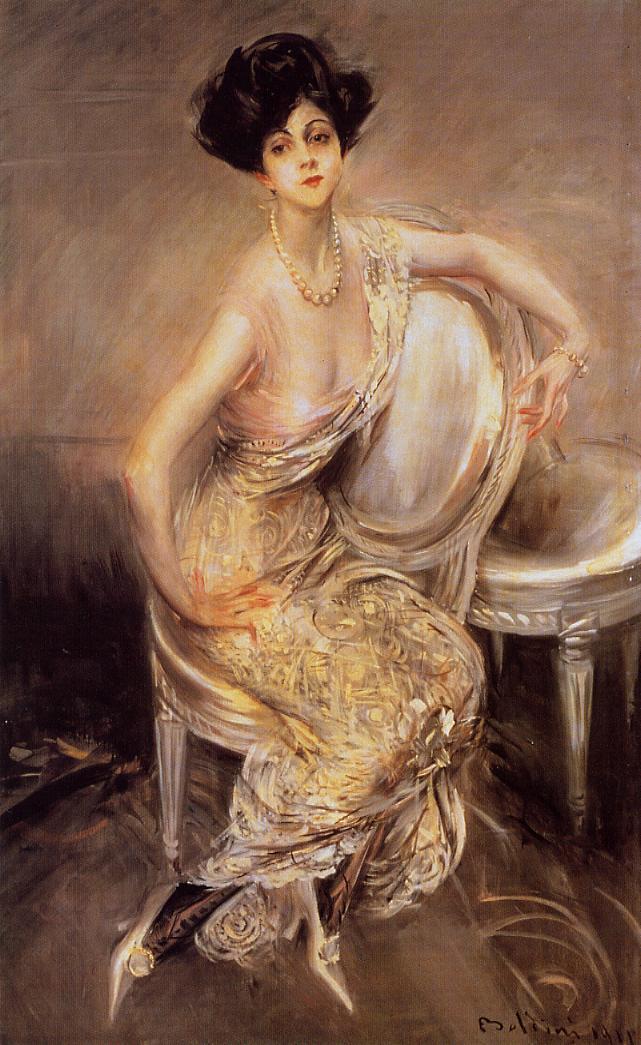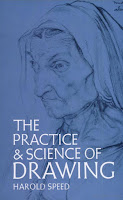 On the GJ Book Club, we're looking at Chapter 17: "Portrait Drawing" in Harold Speed's 1917 classic The Practice and Science of Drawing.
On the GJ Book Club, we're looking at Chapter 17: "Portrait Drawing" in Harold Speed's 1917 classic The Practice and Science of Drawing.Now we arrive at a solid chapter that is full of Speed's best thoughts about how to approach a portrait. He's not only talking about drawing, but about painting, too. I'll paraphrase Speed's points in bold, followed by further comments and links to previous GJ posts that discuss the topic further.
1. An individual's personality affects the outward appearance of their face, both the overall form and the features.
This leads to a question I've often pondered when I'm riding the subway or looking at criminal's mugshots. Can you read a person's biography from their face alone? How much are our innermost lives written on our faces?
2. The real object of the portrait painter is to seize on these unique characteristics of the sitter, even if they are shy and self-conscious about those qualities.
Speed says, "Some close study of individual characteristics must be the aim of the artist." Recent studies of face recognition have shown that the way we remember faces is by cataloguing the ways they deviate from the norm. We keep a mental catalog of their unusual qualities.

Caricaturists know this (above by David Boudreau) and they're experts at emphasizing those deviations.
 |
| King George V by Joseph Solomon |
In Speed's words: "Catching the likeness, as it is called, is simply seizing on the essential things that belong only to a particular individual and differentiate that individual from others, and expressing them in a forceful manner."
4. No two people look alike; even if the differences are slight, we can recognize someone after a long time or from far off.
We've all noticed this when we see someone we know in a crowd way off. We're also attuned to recognizing very slight differences in body posture and walk cycles, too, which is why a walk cycle is a central job of designing an animation character.
5. We record the memory of a face not as a collection of individual details, but as a gestalt, or an overall impression.
He says it's important not to dwell too much on any one feature, but to develop the whole subject as a general impression and get that right before honing into the details. You can see this in quick portrait sketches (above) or unfinished paintings by master portraitists.
6. Your eye has to be "fresh" to recognize these differences. If you've been looking at your picture for too long, you lose sight of the uniqueness of the subject.
The best illustration of this is this video, which will blow your mind if you haven't seen it before. Look at the cross in the middle of the frame, as unaltered photos of celebrity faces flash by. They will appear to be distorted caricatures, but they're not. Your "fresh eye" is seeing them as distinct and unique variations.
7. Look for great qualities in the old masters, and then seek those qualities as you observe living examples in nature.
Another point Speed makes is to get to know the person's biography first, at least the main qualities of his temperament that are likely to have influenced his or her face. Another way I think of this is, what is their central metaphor? What is the basic story they keep telling about themselves? Do they present themselves as a victim, a clever trickster, a lover, a thinker, or a rogue? Speed says, "The habitual cast of thought in any individual affects the shape and moulds the form of the features. So I would say, chat it up with the person, and if possible keep them talking throughout the sitting. If they're sitting there like a wooden statue, there's no way you'll capture their true likeness.
8. Get the exact proportions correct first. The metrics have to be right.
We saw this in an earlier post when I interviewed one of the artists for Madame Tussaud's.
 |
| Portrait by Boldini |
9. Speed's criticism of the "striking" portrait.
Speed says, "Probably the most popular point of view in portraiture at present is the one that can be described as a "striking presentment of the live person. This is the portrait that arrests the crowd in an exhibition. You cannot ignore it, vitality bursts from it, and everything seems sacrificed to this quality of striking lifelikeness. And some very wonderful modern portraits have been painted from this point of view."
He then goes on to question this fashion. I'm not sure exactly who he had in mind, but it might be Boldini, who did many such striking portraits, and they're related to the bravura of Hals. I doubt that Speed is criticizing Sargent, but he might be.

9. Speed outlines two methods for developing the portrait:
a) Mass in the impression, then finish the eyes first and then finish the rest of the face, moving outward from the eyes. Some contemporary painters advise actually constructing the face outward from the eyes, a more radical version of what Speed is proposing—but this method, I believe, is prone to errors in construction.
b) Block in the overall impression and develop areas throughout the face all together, finishing up the eyes later in the process.

10. Speed's classifications of portrait styles:
a) The quiet and sober portraits of Holbein (above).
b) "Seeking in the face a symbol of the person within." He gives the example of G.F. Watts (below).
 |
| Watts portrait of Wm. Morris |
11. Speed cautions against capturing momentary expressions (or contemporary fashions).
He traces this to the ability of the camera to capture a smile. Speed says you wouldn't want to live with a person who is smiling all the time (creepy), so you wouldn't want to live with a portrait like that, either. What would Speed think of modern portraits, where the fashion nowadays is to show the subject grinning? A "fixed smile is terrible," Speed says.
No one can hold a smile very long. That's why someone needs to count down "3, 2, 1, Cheese!" when we take a smiling photo. (See my previous post on Smiling Presidents)
Feel free to offer your comments on any of the points mentioned above, or other points I may have missed.
-----
The Practice and Science of Drawing is available in various formats:
1. Inexpensive softcover edition from Dover, (by far the majority of you are reading it in this format)
3. Free online Archive.org edition.
Articles on Harold Speed in the Studio Magazine The Studio, Volume 15, "The Work of Harold Speed" by A. L. Baldry. (XV. No. 69. — December, 1898.) page 151.
and The Windsor Magazine, Volume 25, "The Art of Mr. Harold Speed" by Austin Chester, page 335. (thanks, अर्जुन)
GJ Book Club on Pinterest (Thanks, Carolyn Kasper)
GJ Facebook page
Overview of the blog series
Announcing the GJ Book Club
Chapter 1: Preface and Introduction
Chapter 2: Drawing
Chapter 3: Vision
Chapter 4: Line Drawing
Chapter 5: Mass Drawing
Chapter 6: Academic and Conventional
Chapter 7: The Study of Drawing
Chapter 8: Line Drawing, Practical
Chapter 9: Mass Drawing
Chapter 10: Rhythm
Chapter 11: Variety of Lines
Chapter 12: Curved Lines
Chapter 13: Variety of Mass
Chapter 14: Unity of Mass
Chapter 15: Balance
Chapter 16: Proportion
Chapter 17: Portrait Drawing
Chapter 18: Visual Memory
Chapter 19: Procedure
Chapter 20: Materials
Overview of the blog series
Announcing the GJ Book Club
Chapter 1: Preface and Introduction
Chapter 2: Drawing
Chapter 3: Vision
Chapter 4: Line Drawing
Chapter 5: Mass Drawing
Chapter 6: Academic and Conventional
Chapter 7: The Study of Drawing
Chapter 8: Line Drawing, Practical
Chapter 9: Mass Drawing
Chapter 10: Rhythm
Chapter 11: Variety of Lines
Chapter 12: Curved Lines
Chapter 13: Variety of Mass
Chapter 14: Unity of Mass
Chapter 15: Balance
Chapter 16: Proportion
Chapter 17: Portrait Drawing
Chapter 18: Visual Memory
Chapter 19: Procedure
Chapter 20: Materials









5 comments:
"A portrait is a painting with something wrong about the mouth." John Singer Sargent
It's intimidating to try and comment about a) a chapter I haven't read yet (somewhere I got behind and have been a chapter behind for weeks!), and b) something with which I don't have a lot of experience (drawing/painting portraits). Alas, I'm going to anyway...
#7: My experience with portraits mostly lies in photography, but it's interesting to me how the same things apply, at least when it comes to a photographic portrait vs. snapshots. My wife does a much better job at photographically capturing the essence of a person than I primarily because she and the sitter are much more at ease with each other doing the shoot (she's more of a people person than I). In general I find a relaxed subject is always more interesting and enjoyable to work with unless tension is what you're after, in which case you better work quickly before tension turns into ugly.
The other thing that comes to mind is the reinforcement of the importance of 'seeing' and studying, which I find as I've gotten back into drawing and painting are necessary and frankly irreplaceable. There are no shortcuts to doing something well.
Thanks for the thoughts and insights as always!
Thanks for doing this book club. I haven't been commenting until this week, but the effort is appreciated!
It makes sense to me to start from the eyes. If you don't get them right, you won't have a likeness. (Wrong eyes can make even recognizable faces completely alien, as the internet discovered a few years ago when people start editing Steve Buscemi's eyes onto everything.)
I tried my first ever portrait.
http://robertbrittonjr.blogspot.com/2015/08/my-first-portrait-ever-teddy-roosevelt.html
I have always been afraid of doing portraiture. Unlike a landscape, people can easily judge whether you've gotten a likeness of someone, let alone an expression of their personality.
Having done this first one for myself, I really begin to understand that there is a lot of mastery in doing portraiture right. it's not just a matter of shapes and lines, but a matter of getting an expression of who that person really is. Some of these pure facial portraits make it hard to capture the essence of a person. When you can put a person in their setting, doing something, standing a certain way that is naturally expressive of who they are, it becomes much more representative of their personality, IMHO.
I have a few progress photos of how I tried my first portrait. I'm not sure if it's something I'll stick with, but I think it's representative of more of the 'line and form' method espoused by Schmid as a start.
It was hard, but fun. So many little curves that need to be represented just so. It was both easier than I thought (placement of major achor points), and harder than I thought (adjusting curves of the mouth, nose, eyes, etc.)
Post a Comment